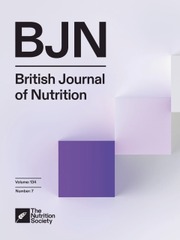Article contents
Effects of dietary carbohydrate and lipid levels on growth performance, hepatic histology and antioxidant capacity and flesh texture of mandarin fish (Siniperca chuatsi)
Published online by Cambridge University Press: 23 December 2024
Abstract
In this study, nine isonitrogenous experimental diets containing graded levels of carbohydrates (40 g/kg, 80 g/kg and 120 g/kg) and crude lipids (80 g/kg, 120 g/kg and 160 g/kg) were formulated in a two-factor (3 × 3) orthogonal design. A total of 945 mandarin fish with similar body weights were randomly assigned to twenty-seven tanks, and the experiment diets were fed to triplicate tanks twice daily for 10 weeks. Results showed that different dietary treatments did not significantly affect the survival rate and growth performance of mandarin fish. However, high dietary lipid and carbohydrate levels significantly decreased the protein content of the whole body and muscle of cultured fish. The lipid content of the whole body, liver and muscle all significantly increased with increasing levels of dietary lipid, while only liver lipid level was significantly affected by dietary carbohydrate level. Hepatic glycogen content increased significantly with increasing dietary carbohydrate levels. As to liver antioxidant capacity, malondialdehyde content increased significantly with increasing dietary lipid or carbohydrate content, and catalase activity showed an opposite trend. Superoxide dismutase activity increased significantly with increasing levels of dietary lipid but decreased first and then increased with increasing dietary carbohydrate levels. Additionally, the increase in both dietary lipid and carbohydrate levels resulted in a significant reduction in muscle hardness. Muscle chewiness, gumminess and shear force were only affected by dietary lipid levels and decreased significantly with increasing dietary lipid levels. In conclusion, considering all the results, the appropriate dietary lipids and carbohydrate levels for mandarin fish were 120 g/kg and 80 g/kg, respectively.
- Type
- Research Article
- Information
- Copyright
- © The Author(s), 2024. Published by Cambridge University Press on behalf of The Nutrition Society
Footnotes
These authors contributed equally to this work.
References
- 1
- Cited by



